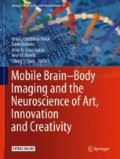Abstract
This research presents an overview of the extended applications of enactive and embodied music cognition within creative music and sonic art practice. Digital and haptic technologies, improvisation, and performance have been used to explore a range of interdisciplinary collaborations from pedagogy to health and wellbeing, as well as music perception.
Access this chapter
Tax calculation will be finalised at checkout
Purchases are for personal use only
References
Blacking, J.: How Musical Is Man?. University of Washington Press, Seattle (1974)
Cadoz, C.: Instrumental gesture and musical composition. In: Proceedings of the 1988 International Computer Music Conference, San Francisco (1988)
Davidson, P.W.: Haptic perception. In: S. of Pediatric Psychology (ed.) J. Pediatr. Psychol. 1(3), 21–25. Oxford University Press, Oxford (1976)
DeNora, T.: Music in Everyday Life. Cambridge University Press, Cambridge (2003)
Emmerson, S.: Music imagination technology. In: Proceedings of the 2011 International Computer Music Conference, Huddersfield (2011)
Ferguson, J.R.: Imagined agency: technology, unpredictability, and ambiguity. Contemp. Music Rev. 32(2–3), 135–149. Taylor & Francis, London (2013)
Ferrari, P.F., Rizzolatti, G.: Mirror neuron research: the past and the future. Philos. Trans. R. Soc. Lond. B Biol. Sci. 369(1644), 20130169 (2014). https://doi.org/10.1098/rstb.2013.0169
Gallagher, S., Hutto, D.D., Slaby, J., Cole, J.: The brain as part of an enactive system. Behav. Brain Sci. 36(4), 421–422 (2013)
Glennie, E.: Hearing essay. https://www.evelyn.co.uk/hearing-essay/ (1993). Accessed 23 Nov 2018
Grote, F., Andersen, K., Knees, P.: Collaborating with intelligent machines: interfaces for creative sound. In: Proceedings of the 33rd Annual ACM Conference on Human Factors in Computing Systems. Seoul, 18–23 April 2015 (2015)
Hayes, L.: Practice and research in enactive sonic art. http://www.pariesa.com (n.d.). Accessed 23 Dec 2018
Hayes, L.: Vibrotactile feedback-assisted performance. In: Proceedings of the International Conference on New Interfaces for Musical Expression. Oslo (2011)
Hayes, L., Michalakos, C.: Imposing a networked vibrotactile communication system for improvisational suggestion. Organ. Sound 17(1), 36–44. Cambridge University Press, Cambridge (2012)
Hayes, L.: Haptic augmentation of the hybrid piano. Contemp. Music Rev. 32(5), 499–509. Taylor & Francis, London (2013)
Hayes, L.: Skin Music (2012): an Audio-haptic composition for ears and body. In: Proceedings of the ACM SIGCHI Conference on Creativity and Cognition. Glasgow, 2012 (2015)
Hayes, L.: Enacting musical worlds: common approaches to using NIMEs within both performance and person-centred arts practices. In: Proceedings of the International Conference on New Interfaces for Musical Expression. Baton Rouge (2015)
Hayes, L., Rajko, J.: Towards an aesthetics of touch. In: Proceedings of the 4th International Conference on Movement Computing. ACM, London (2017)
Hayes, L.: Live electronic music performance: embodied and enactive approaches. In: Proceedings of the 5th International Conference on Movement Computing. ACM, Genoa (2018). https://doi.org/10.1145/3212721.3212891
Hayman, G.: Mirror neurons, Husserl, and enactivism: an analysis of phenomenological compatibility. Perspectives 6(1), 13–23 (2016)
Ingold, T.: The Perception of the Environment: Essays on Livelihood, Dwelling and Skill. Routledge, London (2000)
Loaiza, J.M.: From enactive concern to care in social life: towards an enactive anthropology of caring. Adapt. Behav. (2018). https://doi.org/10.1177/1059712318800673
Matyja, J.R., Schiavio, A.: Enactive music cognition: background and research themes. Constr. Found. 8(3), 351–357 (2013)
Merleau-Ponty, M.: Phénoménologie de la perception (1945). English edition: Merleau-Ponty, M.: Phenomenology of Perception (trans: Smith, C.). Routledge and Kegan Paul, London (1962)
Molnar-Szakacs, I., Overy, K.: Music and mirror neurons: from motion to’e’motion. Soc. Cogn. Affect. Neurosci. 1(3), 235–241 (2006)
O’Modhrain, S.: Playing by feel: incorporating haptic feedback into computer-based musical instruments. Ph.D. Dissertation. https://ccrma.stanford.edu/~sile/thesis.html (2001). Accessed 23 Dec 2018
Paterson, M.: The Senses of Touch: Haptics, Affects and Technologies. Berg, Oxford (2007)
Rebelo, P., Coyne, R.: Resisting the smooth: time-based interactive media in the production of distressed space. In: Digital Design: 21st eCAADe Conference (2003)
Roebuck, J.: I am a deaf opera singer. http://www.theguardian.com/theguardian//sep/29/weekend7.weekend2 (2007). Accessed 1 Dec 2018
Small, C.: Musicking: The Meanings of Performing and Listening. Wesleyan University Press, Middletown (2011)
Varela, F.J., Thompson, E., Rosch, E.: The Embodied Mind: Cognitive Science and Human Experience. MIT Press, Cambridge (1991)
Acknowledgements
Images courtesy of Craig Jackson and Jason Thrasher.
Author information
Authors and Affiliations
Corresponding author
Editor information
Editors and Affiliations
1 Electronic Supplementary Material
Below is the link to the electronic supplementary material.
Excerpts from audio-haptic installation, Skin Music, 2012 (MOV 42744 kb)
476737_1_En_7_MOESM2_ESM.mp4
Figurine-Operated String, 2012 (for piano and live electronics) (MP4 29419 kb)
Improvising with the hybrid analogue-digital performance system (MP4 82148 kb)
Media Example 2
Figurine-Operated String, 2012 (for piano and live electronics) (MP4 29419 kb)
Rights and permissions
Copyright information
© 2019 Springer Nature Switzerland AG
About this chapter
Cite this chapter
Hayes, L. (2019). PARIESA: Practice and Research in Enactive Sonic Art. In: Contreras-Vidal, J., Robleto, D., Cruz-Garza, J., Azorín, J., Nam, C. (eds) Mobile Brain-Body Imaging and the Neuroscience of Art, Innovation and Creativity. Springer Series on Bio- and Neurosystems, vol 10. Springer, Cham. https://doi.org/10.1007/978-3-030-24326-5_7
Download citation
DOI: https://doi.org/10.1007/978-3-030-24326-5_7
Published:
Publisher Name: Springer, Cham
Print ISBN: 978-3-030-24325-8
Online ISBN: 978-3-030-24326-5
eBook Packages: Biomedical and Life SciencesBiomedical and Life Sciences (R0)

